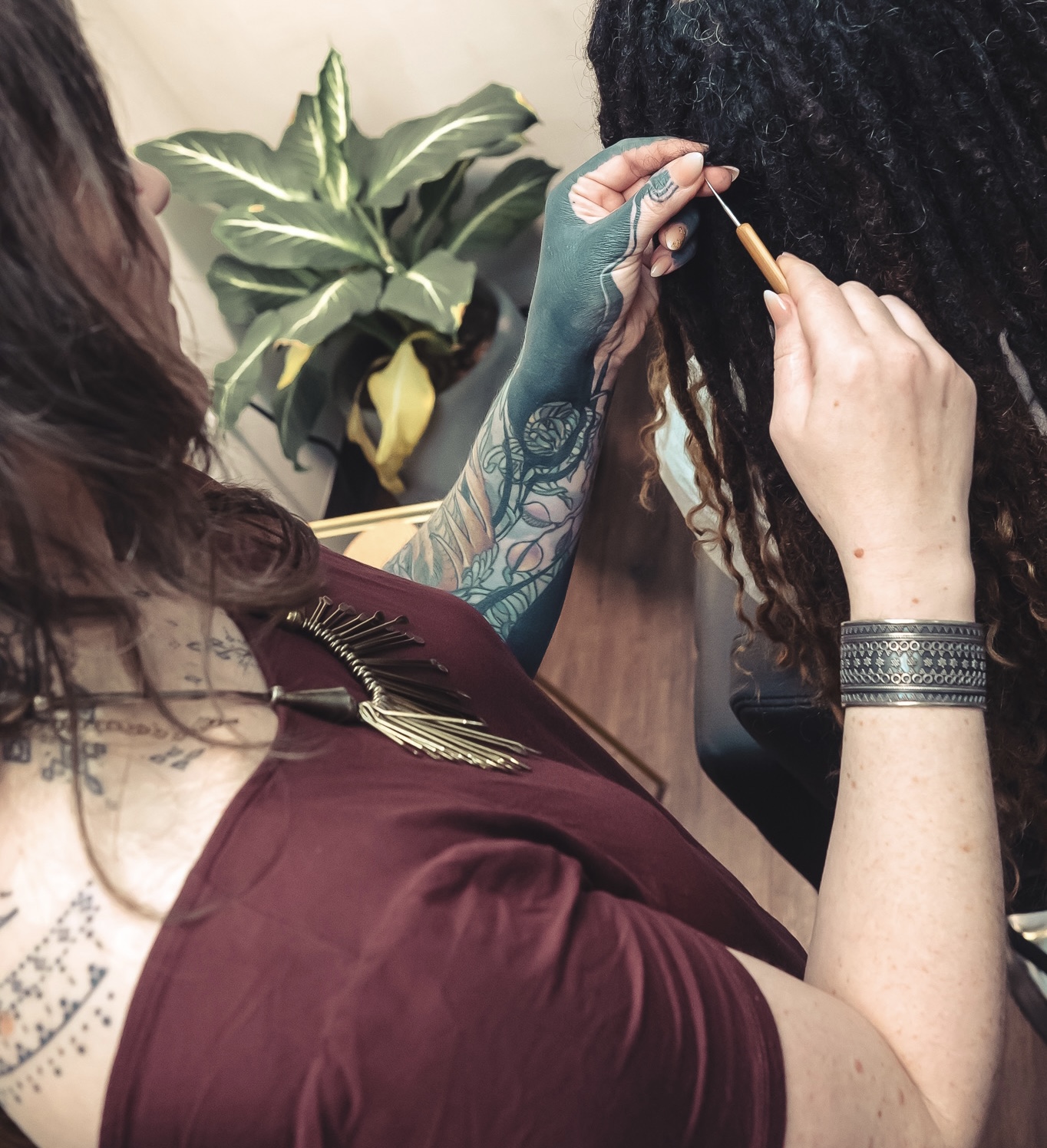CARE GUIDE
Discover new tips and expert advice for maintaining healthy, beautiful locs
Wash
Once a week tends to be the norm depending on lifestyle. Focus suds on the scalp and rinse thoroughly.
Dry
Microfiber towels are great for drying in a humid climate. Be weary of heat damage from dryer use, and bacteria if it’s wet for too long.
Style
Not too tight. Wear wide bands that don’t pinch and not putting too much weight pulling on one loc or ceating weak spots.
More in Depth
How do I wash my locs?
I recommend shampooing once a week. Some of my clients shampoo every two weeks, or twice a week, but that really depends on your lifestyle and scalp biome. Your scalp shouldn’t feel greasy or waxy. For very active folks it’s totally fine to rinse your hair with water after activity more regularly. When shampooing focus your attention on the scalp, it’s unnecessary to shampoo down the lock unless you start seeing buildup. Keep in mind that everything that you wash your scalp with will rinse down the loc, and a lot of times get trapped. So squeeze out those suds. When picking a shampoo it’s important to avoid ingredients that leave behind residue. See a list of my favorite shampoos on my Favorite Products page.
What can I do to maintain them at home between maintenance sessions?
Root rubbing, separating, and palm rolling are great ways to keep your hair happy between maintenance sessions. I don’t recommend using a crochet hook on your own. It takes an insane amount of practice to not break the hairs and crochet properly. Separating is easiest when the hair is wet, during washing. Feel around the sectioning and pull the locs apart from each other at the root area. Palm rolling and stretching is a little more important for new locs but can be helpful at the root area for matured locks. I found the best time to palm roll is after washing, after the hair is mostly dry. For new locks do this for a minimum once a week if you want less texture to form. If you enjoy the lumps and bumps no need to palm roll. If you want no texture at all, the more palm rolling the better, if you can every day that’s great if they are new.
How do I wash my hair if I have a partial?
Shampoo that is safe for brush-able hair is a lot of times not safe for locked hair. But there are some loc appropriate shampoos that are also good for brush able hair. When washing and conditioning your brush-able hair with anything that’s not appropriate for locs, avoid rinsing out that product through your locked hair. It’s sometimes helpful to clip your locks back behind your shoulders to shampoo and condition brush-able hair separately in front. You can also wash all of your hair together with loc appropriate shampoo and just condition the brush-able hair separate.
What are the best ways to dry them?
Letting the hair stay wet for too long will grow bacteria, it’s unhealthy for your scalp biome and the longevity of the loc. My favorite way of drying is to squeeze out the hair with a microfiber towel. If you are using a hand held blowdryer, be sure to not have the heat too high and keep the dryer moving to avoid heat damage. If you’re experiencing a lot of frizz, drying it all the way with a dryer is going to make that worse. You can experiment with using a combination of the two. It’s just important not to go to bed with your hair wet, and don’t let it be wrapped in a towel for hours. I don’t like dryer bag attachments because people tend to turn up the heat too high with the majority of the heat focusing on the fragile ends. When using a dryer attachment, use a high air flow setting and a low temperature setting.
How do I know if I have buildup or not?
Buildup usually happens from a mixture of soap residue, skin, and oils from the scalp. This can happen most commonly from not using the right shampoo or not rinsing the soap all the way out. The buildup area will feel hard, look lighter than the remainder of the lock, and a lot of times it’s around “2 off the scalp towards the back. Sometimes when you see buildup you can just spot treat it, while washing squish some shampoo in there and twist it tight to squeeze the residue out. You can also do a deep cleaning with baking soda and apple cider vinegar. This is a service that I offer, but you can also do it at home. I usually recommend a deep cleaning after the locs are matured, then once a year after.
What is the best way to sleep on my locs?
It’s best to wrap your hair in silk or satin when you sleep. This helps prevent frizz on the lock, and wear and tear on loose ends if you have them. Bonnets are great if you can keep one on your head comfortably while you sleep. There are brands with no slip bonnets for active sleepers, tube styles for long locs, and turban styles that are very cute. I have a couple links for them in my Favorite Products page. A lot of people have a really hard time sleeping with a bonnet, so I recommend using a silk pillowcase. Silk is really going to be better for your hair and face than satin because it’s antimicrobial. If your locks are very long, don’t lay on them while you sleep. Place them up above your pillow if they aren’t inside a bonnet. If you have a partial it’s nice to separate the brush-able hair with a bun or braid.
How do I take care of my extensions with loose ends?
Human hair extensions take a little extra care, especially ones with loose ends. This is because the hair is no longer living, and has gone through sanitizing, dying, and re-waving process. I’ve noticed that the locked area of the extension gets softer over time and responds well to moisturizing products that are appropriate for locs (see my Favorite Products page.) These types of products preserve the extensions and help them last for longer. For extensions with loose hair at the ends, be sure to gently condition once or twice a week, avoiding getting the conditioner on the loc, this is only for the loose end. Be aware that anything you use for your locks will rise through to your ends when you wash. So drying shampoos and tightening sprays, though good for the locked hair, can coat your brush-able ends and ultimately lock that hair as well. Keratin treatments and protein treatments (or shampoos with these in them) are not appropriate for human hair extensions and will typically make the hair very brittle over time depending on the strength of the product. If you think your home may have old pipes or hard water, a charcoal shower filter will help both your skin and your hair. Avoid chlorine or any hair dye or toner involving processing solution or peroxide. If you want to dye your extensions it’s best to refer to a professional that’s experienced with dying extension hair as it behaves differently than natural hair. When using heat, always use a heat protectant, I have a couple on my Favorite Products page. After the loose ends are conditioned and fully dried, preferably air dried with a microfiber towel, use oil or leave in conditioner to pick out the ends. Use a single pick end, not a comb or detangler. Be sure to pinch the connection between the lock and the loose hair, then pick gently upwards from the tip. Some small amount of shedding is normal within the first couple weeks, but if there’s a lot you’re being too rough. If you need to pick them out more than once a week then there is something in your routine that is affecting the hair negatively.
Can you give me some advice for my scalp trouble?
If you think you may have a scalp condition it’s best to see a dermatologist. Sometimes locking the hair makes scalp conditions better or worse. There is usually a month that the scalp is adjusting to the newly locked hair. Sometimes the more pure nature of loc shampoo can be helpful if it’s a minor issue. There are medicated shampoos that are great for dry scalp that are safe for locked hair, see my Favorite Products page. If your scalp is just a little sensitive and itchy, some people experience that in the first week or so of having new locs and that usually settles down on it’s own. Mint, Tea Tree, and rosemary oil are great for scalp discomfort, dilute them with water in a spray bottle, dropper, or roller ball.
Can I color my locs?
If you are the kind of person that changes your color often, more than every two years, I would suggest creating change with temporary wool filler locs you can easily take in and out amongst your natural locs. If you have human hair extensions, it is possible to dye them, but because of the processing the hair goes through I highly recommend going to a color specialist that is experienced with dying extension wefts, as the hair responds very differently to the color formulation. Henna, though it’s “natural” contains heavy metals that build up in the hair and can be incredibly damaging to any hair. I always suggest going to a professional for color services, and I can give you some recommendations, but I know people have fun with color at home. Direct dyes, color without processing solution, aren’t damaging for the hair, but it only turns out nice on bleached hair.

CUSTOM
Here’s a little disclaimer. This page has some great tips and tricks for your locked hair. It’s knowledge that I’ve gathered throughout my career. But everyone is different. Everyone’s hair, scalp, environment, and lifestyle are different. During our maintenance sessions I monitor my clients hair for any signs of trouble and I’ll offer a more catered home maintenance regiment.
